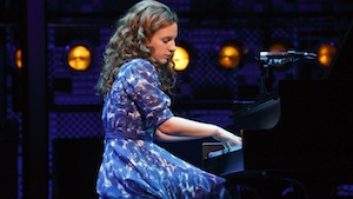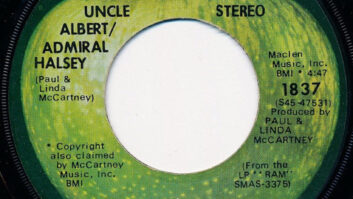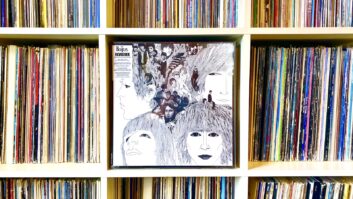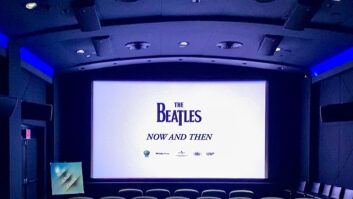Keeping Rain steady are (l-r): Crain Van Tassel, monitor engineer; Abe Jacob, sound designer; and Jim vanBergen, production sound engineer/FOH mixer, pausing at the production’s DiGiCo SD8 console.They say that what goes around, comes around, and for Abe Jacob, that’s certainly the case. In 1966, Jacob was part of the team that provided sound for The Beatles’ last official concert, held at San Francisco’s Candlestick Park. Then, 10 years later, he tackled sound design for Broadway’s Beatlemania and Robert Stigwood’s off-Broadway stage production of Sgt. Pepper’s Lonely Hearts Club Band. Now, more than three decades on, he’s returned to the Fab Four’s music again, having created the sound design for Rain: A Tribute to The Beatles on Broadway.

1970s, Rain has toured the world, gaining such notice that it provided music for the TV movie Birth of The Beatles. Having toured for years, the performers today have their show down pat, and carry a standard lighting and sound rig on the road to augment their production. When Rain began its Broadway run this past fall, however, the show had to be taken to the next level in order to meet the discerning expectations of New York theater audiences.
To that end, the production brought in Jacob, whose background includes touring with Jimi Hendrix; sound designing Broadway classics like Evita, Dancin’ and A Chorus Line; and working today as resident designer at Lincoln Center’s David H. Koch Theatre. For Rain’s Broadway debut, Jacob eschewed the band’s road PA and designed a new audio system specifically for the production. The biggest sound design quandary, however, was whether to treat the show as a concert or a theatrical presentation.
“I hope we’ve been able to achieve both,” said Jacob. “It is a concert; it’s not a Broadway show in the sense of having dialogue and action away from the music, but it is in a Broadway theater, so we created new surround sound effects and provided more of a dynamic range for the show than what Rain does on tour.
“For instance, it starts out with early Beatles music from The Ed Sullivan Show, so it has more of a television sound, which is how everybody first heard them. Later, it goes into Shea Stadium, where they performed but very few people heard what was going on, because of the limited technical facility available back in the ’60s for large outdoor venues. For that, we emphasized the sound of screaming girls which at some points drowned out the music; that’s one of the surround sound effects that is a little different from the normal concert presentation that Rain was used to doing.”
As might be expected, the psychedelic flavor of the Beatles’ later work provided a palate for further experimentation. “All of the EQ, reverb effects and things that they were able to do in the studio, we can now do in real time, eight times a week, with the technology that’s available today both in the console and peripheral outboard equipment,” said Jacob.
That arsenal of modern-day gear starts with a DiGiCo SD8 console at the front-ofhouse position, with 38 inputs overseen by production sound engineer/FOH mixer Jim vanBergen. In The Beatles’ later years, the mixing was as integral to the band’s songs as the instruments, so when Rain began preparing for the Broadway run, Jacob asked the group to take the SD8 on the road in order to fine-tune the effects and levels to best match the studio recordings.
Jacob noted his decision to choose an SD8 was in part because of the desk’s small size and onboard effects, both of which help minimize space requirements for the FOH position. “That’s part of it,” he said, “but it mostly comes down to the SD8’s sonic quality, its ability to import presets, and the onboard processing which covers most of the digital requirements of the effects required to reproduce The Beatles recordings. They were very into automatic double-tracking, flanging, chorusing and various kinds of reverbs—from the live chamber at Abbey Road to electronic plates that were available back then—and all of that is readily available on the SD8.”
Rain emulates the Beatles’ performances from each of their musical eras.Up at stageside, monitor engineer Craig Van Tassel, mans a Yamaha PM5D desk, sending mixes to Sennheiser G2 IEM systems with Ultimate Ears buds worn by the five bandmembers (one performer plays keyboards offstage). “I must say Craig does a terrific job, because not only are there five mixes for the band, but when they have substitutes—somebody comes in to play the bass and sing the lead vocals, for instance—that performer has a different monitor mix than the other person who did it. There are various combinations that have to be worked on [so Van Tassel mixes using] different presets for each different version of the show.”

The audience hears the band, effects and the rest through an extensive PA system provided and tuned by Acme Sound Partners’ Mark Menard and Nevin Steinberg, and created with help from Meyer Sound design services associate, Michael Creason. The heart of the PA is comprised of 14 Meyer Sound JM-1Ps, used as the main left and right stacks. A line array of M2Ds hangs as a center cluster, 700-HPs are used for subwoofers, and front fills are M1Ds.
It’s all a far cry from the system that Jacob helped field back in the ’60s for The Beatles. “The one at Candlestick Park was miniscule compared to what we have today,” he chuckled. “I mean, some straight plays on Broadway have more power than what we had for those concerts back in ’66. At Candlestick, it was 12 Altec A7s with a multi-cellular horn on top. The Beatles played at second base, so there were six along the first and third base lines. There were also some Altec studio monitors, which were side fills for the band on stage, and it was just the four vocal mics and a couple of mics on the drums. There were microphones on the amplifiers, too, but it was basically just a case of trying to get the vocal level above everything else.”
While Rain slavishly impersonates The Beatles down to the most minute details, the circa-1966 sound system is thankfully one element the band is willing to overlook.
Rain
raintribute.com
DiGiCo
digiconsoles.com
Meyer Sound Laboratories
meyersound.com
Yamaha
yamaha.com
Acme Sound Partners
acmesoundpartners.com




